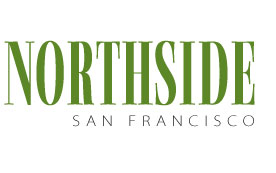| |
|

The Inquisitive Traveler
Relish Riesling
By Patty Burness
Riesling is experiencing a resurgence. This grape is grown in the Northwest, Australia and elsewhere, but it’s the German Riesling that is the stalwart. Romans and Celts first planted vines 2,000 years ago. I recently returned from a tour of the Mosel River region — a lush wine area about two hours 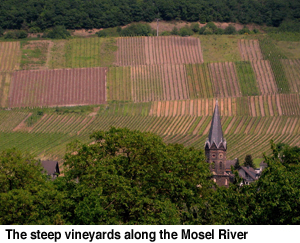 west of Frankfurt. It’s a long haul from the Northside, but once you’re there, stay for a while, and if possible, extend your vacation and venture other places (read about Croatia in next month’s column). west of Frankfurt. It’s a long haul from the Northside, but once you’re there, stay for a while, and if possible, extend your vacation and venture other places (read about Croatia in next month’s column).
Close to France and Luxembourg, the Mosel region (one of Germany’s 13 wine areas) abounds with steep vineyards, slate soil, terraced hillsides, and verdant valleys that run along the Mosel River and its tributaries — the Saar and Ruwer Rivers. Rieslings from this area have the right combination of residual sugar and acid to produce elegant and balanced wines. And with the low alcohol level (around 8 percent), it’s easy to have another glass.
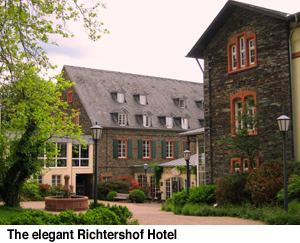 Home base for my wine excursion was Weinromantikhotel Richtershof, a member of the luxurious Relais & Chateaux group. Situated in the little town of Mülheim on the east bank of the river in the Middle Mosel, it’s all about relaxation and enjoyment. In fact, their mantra is “a hotel to feel well, a gastronomy to enjoy, and a wine-growing estate to explore.” Each unique room is beautifully decorated and comfortable with views of the surrounding park and vineyards. Herb gardens, patios and a lily pond await outside. The Richtershof opened in 2000 and is adjacent to the Max Ferd. Richter Winery. Home base for my wine excursion was Weinromantikhotel Richtershof, a member of the luxurious Relais & Chateaux group. Situated in the little town of Mülheim on the east bank of the river in the Middle Mosel, it’s all about relaxation and enjoyment. In fact, their mantra is “a hotel to feel well, a gastronomy to enjoy, and a wine-growing estate to explore.” Each unique room is beautifully decorated and comfortable with views of the surrounding park and vineyards. Herb gardens, patios and a lily pond await outside. The Richtershof opened in 2000 and is adjacent to the Max Ferd. Richter Winery.
Every morning starts in the garden restaurant, formerly a butcher shop from 1911. The extravagant buffet offers champagne, omelets, pastries, cheeses, salumis, fruits, breads, and coffee — full fortification for the day ahead. At night, dinner is equally sumptuous served in an intimate setting. Only the freshest ingredients are used, and whether you enjoy squab, perch or any other selection from the seasonal menu, you’ll delight in the flavors — especially with those German Rieslings that complement so many flavors (spicy and sweet Asian, Indian, Caribbean).
(Time to throw out any memories of Blue Nun and get serious about the wine. Before you read about my experiences, check out the information about Riesling in the Essentials box below.)
The region’s statistics are staggering: 70 million vines on 23,000 acres (half on slopes from 328 to 935 feet high), and 5,000 winemakers in 125 villages and towns. It is the largest contiguous planting of the Riesling grape in the world and the fifth largest wine region in Germany. Ready to taste?
There are lots of ways to tour the Mosel — hiking, biking, via the river (ferry, canoe, row boat) and, of course, by car. Bicycle was the mode of transport for my group. The first stop was immediate: The Max Ferd. Richter Winery right next door to the hotel. The cellar was built in 1880, although the current owner’s ancestors started a wine and food business in Mülheim over three centuries ago.
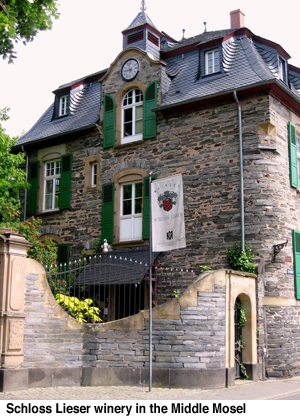 Today, about 95 percent of their vineyards are planted with Riesling. The wines run the gamut from a sparkling to a dessert wine. The 2008 zeppelin label Riesling Mülheimer Sonnenlay (wines from this vineyard were served on the zeppelin airships in the 1920s and 1930s) and both the 2007 Richter Estate Riesling Kabinett and Spätlese even have screw caps. Today, about 95 percent of their vineyards are planted with Riesling. The wines run the gamut from a sparkling to a dessert wine. The 2008 zeppelin label Riesling Mülheimer Sonnenlay (wines from this vineyard were served on the zeppelin airships in the 1920s and 1930s) and both the 2007 Richter Estate Riesling Kabinett and Spätlese even have screw caps.
From the Richter estate, it was less than a mile across the river to the town of Leiser and Weingut Schloss Lieser. The blue slate soil produces wines that are dynamic, refreshing with minerality and tasting of ripe fruit. The vineyards hug some of the steepest hillsides in the Middle Mosel with about a 70 percent grade. Owner Thomas Haag focuses on quality not quantity, and bottles only about 2,500 cases per year with 12–15 wines per vintage. Try the 2008 Schloss Lieser Riesling Spätlese Niederberg Helden — it’s young and lively but can be cellared for 20 years.
Continuing north along the river, we stopped at the estate of S.A. Prum. The proprietors have been making wine along the Mosel for 33 years. The steep blue, grey and red slate hillsides produce enough grapes for over 40,000 cases a year. A delicate balance of acidity and ripeness combine for refreshing, fruity wines. Standouts are two Riesling kabinetts from 2007 — Prum Blue and Wehlener Sonnenuhr.
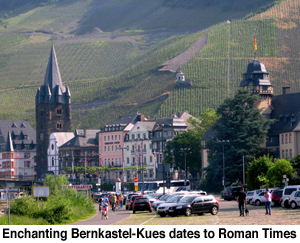 Pedaling south, we crossed the river at Bernkastel-Kues, a picturesque 700-year-old town in the center of the Middle Mosel. Dating to Roman times, medieval architecture abounds. High atop a hill stand the ruins of the Castle of Landshut built in 1277 and accidentally burnt down in 1692. Cafes spill into the narrow streets — perfect to enjoy more wine. Pedaling south, we crossed the river at Bernkastel-Kues, a picturesque 700-year-old town in the center of the Middle Mosel. Dating to Roman times, medieval architecture abounds. High atop a hill stand the ruins of the Castle of Landshut built in 1277 and accidentally burnt down in 1692. Cafes spill into the narrow streets — perfect to enjoy more wine.
Off the bikes, we drove to the Ruwer Valley, home of Weingut Reichsgraf von Kesselstatt. This prolific winery, founded over 650 years ago, has plantings along all three rivers — Mosel, Saar and Ruwer, and most are single-site vineyards. The owners produce wines that typify the best of the region’s terroir — mineral-driven, balanced and at a perfect level of ripeness. Favorites include the 2008 Rieslings from the Ruwer — Kaseler Nies’chen (kabinett) and Kaseler Nies’chen (spätlese).
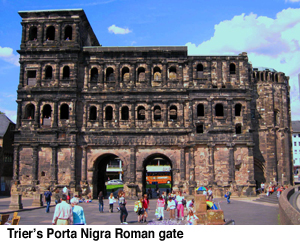 There was time for one final stop along the Mosel. We chose Trier, the oldest city in Germany and site of one of the most famous and best preserved Roman city gates — the Porta Nigra. Translated as “black gate,” it was part of an ancient Roman system of four city gates. Today it’s open to visitors and makes for a great place to start a tour down the town’s main street. Take in shops, cafes, the medieval marketplace, and the plentiful ice cream. There was time for one final stop along the Mosel. We chose Trier, the oldest city in Germany and site of one of the most famous and best preserved Roman city gates — the Porta Nigra. Translated as “black gate,” it was part of an ancient Roman system of four city gates. Today it’s open to visitors and makes for a great place to start a tour down the town’s main street. Take in shops, cafes, the medieval marketplace, and the plentiful ice cream.
Germany’s Mosel region reflects its wine — rich, lush, balanced, and energetic. Enjoy the countryside, bask in the history and best of all — relish the Riesling.
ESSENTIALS
GETTING THERE
Mosel River Region, Germany: About a 14-hour flight from San Francisco to Frankfurt, then about a two-hour drive. www.expedia.com/gogreen; www.eco.orbitz.com.
Tourist Information: www.germany-tourism.de; www.mosellandtouristik.de; www.bernkastel.de.
WHERE TO STAY AND EAT
Weinromantikhotel Richtershof: Hauptstrafpe 81-83, Mülheim, 011-0049-6534-948-0, www.weinromantikhotel.de. Rooms from $189 (includes breakfast), bicycle rentals $12.50/hour, four-course dinner with wine pairing $132 (prices calculated at $1 to €0.69).
DON’T MISS
Max Ferd. Richter Winery: Hauptstrasse 85 Mülheim, 011-0049-6534-933003, www.maxferdrichter.com. Wines available at PlumpJack Wines, 3201 Fillmore Street, 415-346-9870.
Weingut Schloss Lieser Estate: Am Markt 1-5, Lieser, 011-0049-6531-6431, www.weingut-schloss-lieser.de. Wines available at K & L Wine Merchants, 638 4th Street, 415-896-1734.
S.A. Pruem Winery: Uferallee 25-26, Wehlen, 011-0049-6531-3110, www.sapruem.com. Wines available at Beverages & More, 1301 Van Ness Avenue, 415-447-8483; William Cross Wine Merchants, 2253 Polk Street, 415-346-1314.
Weingut Reichsgraf von Kesselstatt: Schlossgut Marienlay, Morscheid im Ruwertal, 011-0049-6500-9169-0, www.kesselstatt.com. Wines available at K & L Wine Merchants, 638 4th Street, 415-896-1734.
MUST TRY
Other Rieslings: St. Urbans-hof 2007 Piesporter Goldtröpfchen Riesling Spätlese, $34.99. Available at D & M Wine & Liquor Co., 2200 Fillmore Street, 415-346-1325.
Weingut Josef Bernard-Kieren 2007 Graacher Dompropst Riesling Kabinett, $17.99. Available at Wine Bar SF, Two Embarcadero, 415-391-0758; Wine Impression, 3461 California Street, 415-221-9463.
Weingut Dr. Thanisch 2008 Riesling Kabinett Bernkasteler Badstube, $21. Available at Sputino Di Ottimista, 1957 Union Street, 415-931-6410.
Air Canada’s Maple Leaf Lounge: Modern spaces offer comfortable places to relax and get work done, too — business centers with free internet access, complimentary beverages, light meals and snacks, local beer on tap — all with great service. Prices and locations: www.aircanada.com.
StashSafe Fanny Pack: This is one ultra safe and roomy fanny pack. Thieves will never get it from you. $64.85. www.magellans.com
Riesling primer
Rieslings range from dry to very sweet and from light to medium body. Although the sugar content is high, the acid balances the flavor to produce fruity and fresh wines with mineral overtones from the slate soil. It is this combination of ripe fruit and acidity that helps Rieslings age well.
Terminology specific to Rieslings further defines the essence of the wine. Kabinett, the lightest of the wines, is picked when the grapes are ripe. Spätlese means “late harvest,” so it has a more intense flavor. Extremely ripe, hand-picked grapes are used in Auslese “select” wine. Beerenauslese refers to “selected berries” for a perfect dessert wine. The grapes are picked overly ripe, have some botrytis fungus, and an intense fruitiness balanced with the acidity. Eiswein grapes are left to freeze on the vine and then pressed while still frozen. The result: a concentrated, sweet dessert wine.
Trockenbeerenauslese are shriveled, botrytis-ravaged beerenauslese grapes — excellent, expensive and rare.
A bit of information about the vineyard Wehlener Sonnenuhr: In 1842 in the small town of Wehlen, a sundial (sonnenuhr) was placed on the most visible rock in this steep vineyard along the Mosel. Now there are over 80 sundials in the area. The grapes from this vineyard with blue slate soil produce some of the more elegant German Rieslings.
Patty Burness is the travel writer for Northside San Francisco. E-mail patty@northsidesf.com.



|
|
|
|
